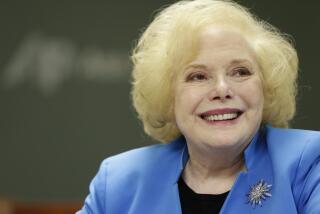How Four Good ‘Mothers’ Changed Analysis : MOTHERS OF PSYCHOANALYSIS: Helene Deutsch, Karen Horney, Anna Freud and Melanie Klein, <i> by Janet Sayers,</i> W. W. Norton & Co., $24.95, 336 pages
When Anna Freud was analyzing future analyst Erik Erikson, she used to knit during their sessions. It would be too much to say that her motherly pastime drove Erikson nuts, but it definitely irritated him. “She disarmed his criticism,” we learn from this useful book by Janet Sayers, “by giving him a handmade sweater for his newborn son.”
It took guts for Anna to sit there clicking away, since her father, Sigmund Freud, had explained that knitting was motivated by women’s desire to conceal “their genital deficiency.”
Women’s genital deficiency is not a very popular notion now. And Freud would be very surprised to see that the practice of psychoanalysis these days is strongly informed by the idea of the therapist, male or female, as a good mother.
Why did Sayers choose to write about four pioneers of psychoanalysis, instead of concentrating on one? Because, she argues, these women are the four who turned the practice around.
All four of these women grew up in turn of the century German-speaking Eastern Europe, then moved to England or the United States and were major figures in early psychoanalytical institutions. Most important, all four questioned why our early feelings about our fathers, Freud’s Oedipus complex, should be so much more significant than our feelings about our mothers.
As to their opinions on their own mothers, Deutsch, Horney, Freud and Klein respectively loathed, adored, ignored and were ambivalent toward them.
Helene Deutsch became a young revolutionary out of hatred for what she called her mother’s “bourgeois materialism.” Her revolutionary activities included an affair at 16.
Sayer’s second subject, Karen Horney, adored her mother. As a child she wrote to her seafaring father, “We are so unspeakably happy when you are not here.”
Horney’s books, including the bestseller “The Neurotic Personality of Our Time,” were blessedly jargon-free and full of the case studies that supply that great pleasure of books on human personality--reading along and finding yourself.
The third of Sayer’s subjects, Anna Freud, virtually ignored her mother as she was growing up, never married, took care of her father and faithfully defended his theories.
Melanie Klein, who, with Anna Freud, became one of the first analysts of children, started out despising her father and idealizing her mother. She began her analytical career by analyzing her own three children, an experience they did not remember kindly.
And who can blame them when we read how Klein out-Freuded Freud in seeking sexual symbols? She believed, for example, that her daughter had trouble thinking through algebraic equations with two unknowns “because of inhibition about thinking about her parents’ sexual intercourse.” A controversial figure who was embroiled in fights with the leaders of the psychoanalytic establishment, Klein gained respect for her treatment of schizophrenia and depression.
Although their lives make for interesting reading, these four psychoanalytic pioneers present problems as heroines. All except Anna Freud were dauntingly charming and charismatic, demanded attention and had lots of affairs--usually with powerful men, sometimes with their patients.
These four hardly constituted a solid sisterhood. Deutsch called Klein, “a housewife with fantasies.” When Deutsch described childbirth as “an orgy of masochistic pleasure” and the ultimate orgasm, Horney derisively said that that had not been her experience in childbirth.
Sayers, who chairs the women’s section of the British Psychological Society and teaches at the University of Kent, is more of a thinker than a writer. In her desire to chase down theoretical arguments, she squeezes in facts that break up the story. Sayers gave herself a tough task, covering four instead of one.
One of the effects of grouping these four that Sayers may not have consciously intended is to demonstrate the strength of Anna Freud. Although she worshipped her father and was the only one of these four who didn’t pay much attention to her mother, she is the one who, by her work, posed the greatest challenge to Freudian theories.
Although she is the only one of the four who was not a mother, Anna Freud, whether knitting or not, certainly seems to be the one who was best at being a mother.
Next: Jonathan Kirsch reviews “Empire of the Air: The Men Who Made Radio” by Tom Lewis (HarperCollins).
More to Read
Sign up for our Book Club newsletter
Get the latest news, events and more from the Los Angeles Times Book Club, and help us get L.A. reading and talking.
You may occasionally receive promotional content from the Los Angeles Times.






